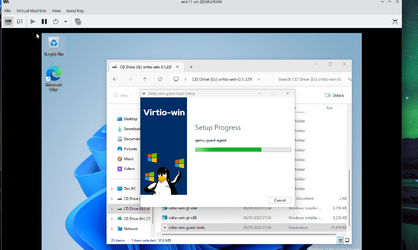- Local time
- 6:00 AM
- Posts
- 5,164
- Location
- Hafnarfjörður IS
- OS
- Windows XP,10,11 Linux (Fedora 42&43 pre-release,Arch Linux)
Hi folks
If using a Linux host for running Windows Guests the built in Hypervisor (KVM/QEMU) approx equiv to Windows HYPER-V is infinitely better than running vbox or vmware products.
However DO run the virtio drivers (disk available from fedora site --free) - this will optimise display, mouse, disk i/o network throughput etc. Run on any known linux build or distro that supports KVM/QEMU -- probably all of them. !!

This iso set performs a similar function to vmware tools on vmware and vbox (or Guest) additions. If you clone the VM to a physical disk you don't need to uninstall these --minimal space !!
Cheers
jimbo
If using a Linux host for running Windows Guests the built in Hypervisor (KVM/QEMU) approx equiv to Windows HYPER-V is infinitely better than running vbox or vmware products.
However DO run the virtio drivers (disk available from fedora site --free) - this will optimise display, mouse, disk i/o network throughput etc. Run on any known linux build or distro that supports KVM/QEMU -- probably all of them. !!

This iso set performs a similar function to vmware tools on vmware and vbox (or Guest) additions. If you clone the VM to a physical disk you don't need to uninstall these --minimal space !!
Cheers
jimbo
My Computer
System One
-
- OS
- Windows XP,10,11 Linux (Fedora 42&43 pre-release,Arch Linux)
- Computer type
- PC/Desktop
- CPU
- 2 X Intel i7
- Screen Resolution
- 4KUHD X 2








